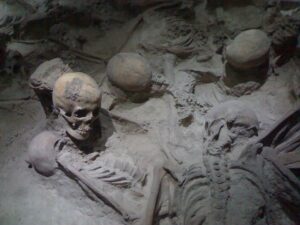
No one knows her name.
The hollow cavities that once held her eyes in her last, terrifying, desperate moment of life nearly 2,000 years ago stared back at me in silence. Surrounded by the articulated skeletal remains of family and friends, her bones told a story of a catastrophe that still echoes across time to this day. I was peering into a cave-like construction that once housed fishing equipment — one among 12 of them — neatly arranged as built in a straight-line row along the back perimeter of what is today a flat but stoney surface. It defined the dimensions of what was once an ancient city’s inviting seaside beach.
Now only a caste replica of the bones she left behind, I knew there was a lost, untold history and personality here that will never be known to today’s living generations.
At least for now, we know how she died, and how quickly.
Through research conducted by a number of researchers, including a team under the leadership of Pierpaolo Petrone of the University Federico II in Naples, scientists have analyzed the skeletal remains of the victims of the volcanic catastrophe of ancient Herculaneum. This research was built upon and confirmed results of previous bioarchaeological and taphonomic studies. Based on the previous studies and their knowledge of how extreme heat can effect the human body, they formulated a horrific and vividly graphic hypothesis for study.
To read more, see the full story at Popular Archaeology Premium.
Cover Image, Top Left: BobFog at Italian Wikipedia, CC BY-SA 4.0, Wikimedia Commons





